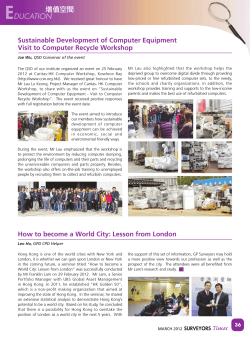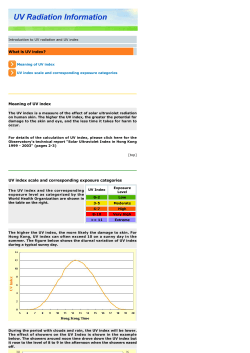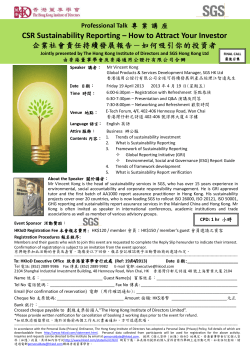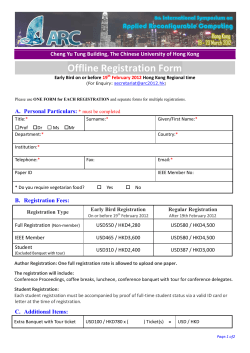
E CONOMIC REVIEW
ECONOMIC REVIEW (A Monthly Issue) February, 2014 Economics & Strategic Planning Department http://www.bochk.com Why Can Hong Kong's Unemployment Rate Continue To Reach New Low? Dai daohua, Senior Economist According to the latest statistics, the seasonally adjusted unemployment rate for Hong Kong from December 2013 to February 2014 dipped to 3.1%, a new low in this recovery cycle and the lowest in sixteen years. Given that the Hong Kong economy grew only 1.5% in 2012 and 2.9% in 2013, a pace slower than the past ten year average of 4.5% or the projected 3.5% trend growth in the medium term, the unemployment rate between 3.1% and 3.5% during the period suggests that there may be changes in Hong Kong's labor market. The improving labor market Hong Kong's latest unemployment rate without the seasonal adjustments stands at 2.9%, also the lowest since February 1998 and below 3.0% for the first time in this recovery cycle. Nowadays, Hong Kong's economy is recovering at a below par pace. Under the circumstances, the unemployment rate continuously declines to the current 3.1% from the high of 5.4% registered in mid-2009 instead of spiking. Sixteen years ago it was the opposite. Ravaged by the Asian Financial Crisis, Hong Kong's unemployment rose quickly from the low of 2.1% just prior to the crisis to 3.0% between December 1997 and February 1998. It ended the year 1998 by surging to 5.9%. Currently, Hong Kong's labor force amounts to 384.43 million, close to the historical high of 388.71 million recorded seven months ago, up nearly 19% from sixteen years ago. Meanwhile, total employment totals 373.18 million, up 17% from sixteen years ago under the same unemployment rate. Moreover, the underemployment rate stands at 1.2%, lower than the 1.6% registered in February 1998. Total underemployment declines to a new low of 46.9 thousand, less than the 52.0 thousand sixteen years ago. The only labor statistics that turns for the worse is the number of total unemployed increasing to 112.5 thousand, higher than the 87.4 thousand sixteen years ago. The unemployment rate is a lagging economic indicator. During the first three quarter of 1997, right before the Asian Financial Crisis, Hong Kong recorded 5.9%, 7.5% and 6.3% real GDP growth. The unemployment rate stabilized at 2.2% by yearend after touching the low of 2.1% in mid-year, even though GDP growth slumped to only 1.1% in 4Q97 before contracting substantially. This time, even though the Hong Kong economy grew no faster The viewpoints in the Economic Review do not necessarily represent the opinions of the Bank of China (Hong Kong) Limited. than 3.1% (2Q13) during the past seven quarters, the unemployment rate has been hovering at low level nonetheless, suggesting different growth drivers. Generally speaking, the performance of the labor market has more to do with nominal economic activities. In this regard, the improving labor market in Hong Kong cannot easily be linked to Hong Kong's nominal GDP, either, because of the mild growth of the latter. After registering growth of 7.1% and 8.9% in 2010 and 2011, Hong Kong's nominal GDP growth decelerated to 5.3% in 2012 and further to 4.9% in 2013. According to the HKSAR Government Budget's estimate, nominal GDP trend growth projection in the medium term is reduced to 5.5% (consisted of 3.5% real growth and 2.0% GDP deflator). Thus, Hong Kong's nominal economic activities do not seem to be robust enough to drive the labor market. Hence, there are two probable explanations for Hong Kong's resilient labor market. Firstly, the domestic economic drivers are stronger than the headline GDP figure suggests. Secondly, even though external trade has been week, its labor market has remained stable, helping to drive the overall unemployment rate to new low. Hong Kong's real GDP growth was only 1.5% in 2012. However, private consumption expenditure, government consumption expenditure and gross domestic capital formation contributed 2.6%, 0.3% and 1.6% of growth, totaling 4.5%, the same as the average overall growth over the past ten years. It was the drag of 0.8% from inventory drawdown and 1.6% from net exports that resulted in the 1.5% headline GDP growth. Inventory declined in both 2011 and 2012, subtracting 2.5% and 0.8% respectively from GDP. Nevertheless, it has to be rebuilt at some point of time given the still robust domestic economic drivers. In the year 2013, the drag turned to a tiny boost of 0.1% of GDP. During the four quarters of 2013, change in inventory contributed 0.5%, -1.6%, 1.0% and 0.5% to GDP growth. Combined with the three domestic drivers, their contribution totaled 4.1%, 3.7%, 3.4% and 4.2% of GDP, all greater than the headline figures of 2.9%, 3.1%, 2.8% and 3.1% of growth, underpinning the labor market. As for external trade, Hong Kong has always been in deficits in terms of goods trade, but surplus in terms of services trade. Hong Kong always imports more goods than it exports. Part of the goods imports are destined for re-exports, the remainder is for domestic use. In 2012 and 2013, retained imports grew 3.0% and 3.7% respectively, similar to the 2.9% and 3.6% growth in goods exports, suggesting similar demands from internal as well as external sectors. The changing labor market Amongst Hong Kong's four pillar industries, the Trading & Logistics Industry contributes 2 the most to value added and employment. According to the statistics till end 2012, the Trading & Logistics Industry accounted for 24.6% of total value added in GDP. Although down from the 28.5% recorded in 2005, it was still substantially higher than the Financial Services Industry's 15.9% share. In terms of employment, the situation was similar, with the Trading & Logistics Industry accounted for 20.9% of total employment. Although down from the 24.4% recorded in 2005, it was also substantially higher than the Professional Services and Other Producer Services Industry's 13.2% share. During the past two years, Hong Kong's external trade experienced setbacks due to external shocks. Growth in both exports and imports were below 4.0%. But the unemployment rate for the import/export trade and wholesale sector declined to 2.7% toward the end of 2013 after initial rise. The unemployment rate for the transportation, storage, postal and courier services, information and communications sector also declined to 2.7%, both below the overall unemployment rate. At the end of 2013, employment in the import/export trade and wholesale sector amounted to 531,200, while that in the transportation, storage, postal and courier services, information and communications sector 443,900, slightly up from 2011's 546,000 and 427,000. This suggests that as Hong Kong's largest employers, the Trading & Logistics Industry did not resort to large scale layoffs, which in turn ensured of the stability in the labor market. In 2009 after the global financial tsunami hit, Hong Kong's seasonally adjusted unemployment rate between June and August surged to 5.5%, while the unadjusted unemployment rate to 5.9%. The construction, retail, accommodation and food services, and manufacturing industries were hit the hardest with unemployment rate surging to 10.3%, 7.6% and 6.4% respectively. The unemployment rate for the import/export trade and wholesale industry was 5.0%, while that for the transportation, storage, postal and courier services, information and communications industry at 4.7% and financing, insurance, real estate, professional and business services industry at a lower 3.8%. Fast forward to 2013, retail, accommodation and food services industry and construction industry still had relatively higher unemployment rate at 4.3% and 4.1% respectively. Given Hong Kong's tourism sector having record visitors, the higher than average unemployment rate for the former is unsettling, casting doubts on the employment potential of the tourism sector. On the other hand, the unemployment rate for the transportation, storage, postal and courier services, information and communications industry was lower at 2.7%, close to the 2.5% for the financing, insurance, real estate, professional and business services industry, contrasting the argument that Hong Kong's trade related industries are sunset industries, at least not from point of view from the historically lower volatility in its unemployment rate. 3 In 2012, the HKSAR Government compiled a report on Hong Kong's manpower requirement projection. The result shows that from 2010 to 2018, the pillar industries of Financial Services, Professional Services and Other Producer Services, and Tourism will see annual average growth of manpower requirement at 2.5%, 2.3% and 2.9% respectively, higher than the overall 1.1% growth. Only Trading and Logistics Industry's average manpower requirement growth will be below par at 0.3%. This projection is based on the assumption of Hong Kong's weakening intermediary role and trade protectionism. This projection is consistent with developments in recent years. But the deterioration in unemployment for the Trading and Logistics Industry has not materialized, arguing for its resilience instead. Full employment Right before the Asian Financial Crisis, Hong Kong's unemployment rate dipped to 2.1% between June and September 1997. Looking ahead, can Hong Kong's unemployment rate drop another percentage point from the current 3.1% to the same level? Judging from the changing economic and demographic landscape, it seems unlikely, as the current 3.1% unemployment rate has already approached the level of full employment. From 3Q96 to 3Q97, Hong Kong's real GDP growth was 4.8%, 6.0%, 5.9%, 7.5% and 6.3% respectively, averaging 6.1%, which was higher than the past ten year average of 4.5% and the projected 3.5% trend growth. Moreover, higher inflation resulted in 10.5%, 13.1%, 12.5%, 14.1% and 12.4% nominal GDP growth for the same period. It was such robust economic activities that led to unemployment rate touching 2.1% at that time. Looking ahead to this year, Hong Kong's nominal GDP growth will likely only come at half of the pace, with trend growth projected at 5.5%. Therefore, maintaining the unemployment rate at current level is a tall task, let alone reducing it further. In mid-1997, Hong Kong's population stood at 6.48 million. But by the end of 2013, it has grown by 11.3% to 7.22 million. Meanwhile, Hong Kong's labor force has risen 20.7% to 3.88 million from 3.21 million, a pace faster than population growth. This means more people are looking for work and the Hong Kong economy has to create more jobs just to keep the unemployment rate steady. As the economy has bid farewell to the phase of rapid growth, the unemployment rate will unlikely revisit the low of 1997, because we have probably approached the full employment threshold given the current economic growth and demographic change. 4 (Key Economic Indicators) . GDP 2012 19,644 1.5 2013 20,372 2.9 2013/Q3 5,124 2.8 2013/Q4 5,416 3.0 2012 2013 2013/12 2014/1 588 33,755 34,343 39,122 4,778 544 35,053 35,597 40,607 5,010 46 3,063 3,109 3,652 544 43 2,992 3,035 3,234 200 10.4 3.2 2.9 3.9 -7.6 3.8 3.6 3.8 -7.9 0.1 0 1.8 -4.3 -0.4 -0.4 -2.7 4.1 4.3 4.3 4.6 115,533 6.2 70,503 -29.9 2012 12.45 3.2 1.5 2013 11.84 3.2 1.4 2014/2 3,987 -58.7 2013/112014/1 11.3 3.1 1.3 2014/1-2 9,084 -45.4 2013/122014/2 11.25 3.1 1.2 2012 9.8 7.2 2013 11.0 10.6 2013/12 5.7 6.1 2014/1 14.5 16.8 ( ) arrivals (ten thousands) (%) Change (%) 4,862 16 5,430 11.7 522 9.3 546 17.8 Financial Market 2012 775.05 2013 775.4 2013/12 775.4 2014/1 776.6 22.2 11.1 11 9.7 12.3 12.4 9.7 12.3 12.4 7.7 9.6 9.6 9.3 11.7 7 10.6 5.1 16.2 10.6 5.1 16.2 7.6 1.2 14.2 17.8 15.7 23 ( ) GDP ($100 Million) (%) Change (%) . External Trade ( ) Total trade ($100 Million) Domestic exports Re-exports Total exports Total Imports Trade balance (%) YOY Growth (%) Domestic exports Re-exports Total exports Imports . Consumer Price (%) Change in Composite CPI (%) . Sale & Purchase of Building Units ( ) No. of agreements (%) Change (%) . Employment ( ) Unemployed (ten thousands) (%) Unemployment rate (%) (%) Underemployment rate (%) . Retail Market (%) Change in value of total sales (%) (%) Change in volume of total sales (%) . . Visitors (US$100 = HK$) H.K. Dollar Exchange Rate (US$100 = HK$) (%) change in Money Supply (%) M1 M2 M3 (%) Change in deposits (%) Total deposits In HK$ In foreign currency (%) Change in loans & advances (%) Total loans & advances 9.6 16 16 use in HK use outside HK Trade financing 7.1 16.5 10.2 13.8 21.4 43.8 13.8 21.4 43.8 5.0000 22,657 5.0000 23,306 5.0000 23,306 (%) Best lending rate (%) Hang Seng index 49.6 5.0000 22,035
© Copyright 2025









